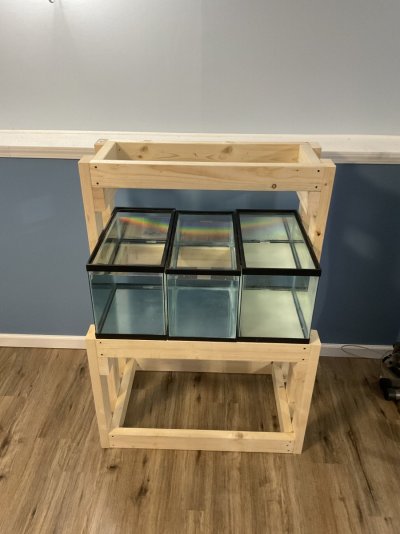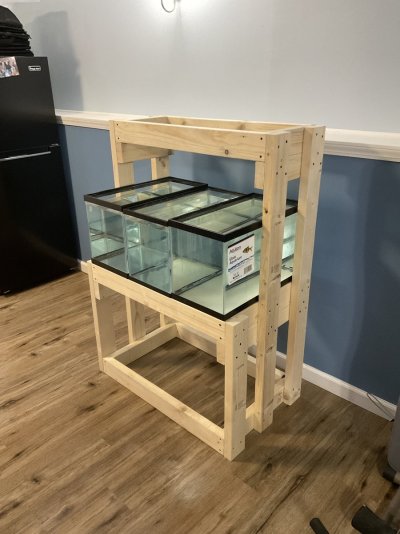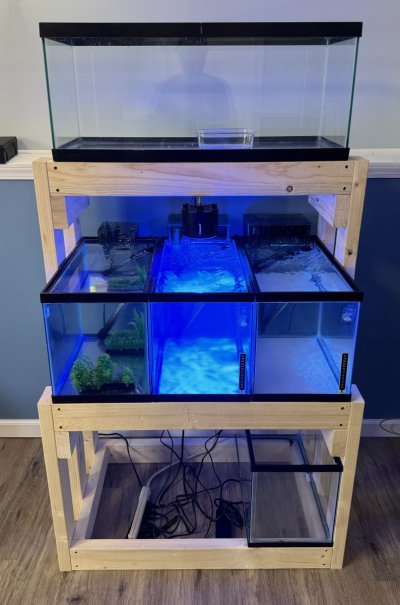- Joined
- Dec 8, 2017
- Messages
- 1,264
- Reaction score
- 1,701
Hi guys!
I am getting back into reefing after a long time off, and I am going to do my best to quarantine, observe and medicate all new arrivals, as best I can and is practical. I've done a lot of research and while there's a lot of different opinions on how to QT fish, I'm going to try to follow the R2R approved fish QT protocol found here.
I recently brought home a Yasha goby that I got on January 14th and added it to a 10 gallon observation tank (bare tank with PVC hides, small dish of inert sand, cycled bio media, no medications). It was understandably stressed, but soon started eating, and has now even started to be a little more confident, though still quite timid.
On january 19th I brought home a Tailspot Blenny and added it to the same QT tank (no medications yet) as the Yasha goby. The blenny has seemed much more stressed, literally curled up in a bare corner of tank, ignoring the PVC hides and the "sandbox". He will sometimes change corners of the tank, but he looks really stressed out. He does eat, he takes frozen and even flaked food. But it makes me nervous how stressed out he seems, though I know this is a timid fish.
My questions would be, when do you start the medicated QT protocol on newly acquired fish? On one hand, I am nervous to medicate a fish that's still obviously stressed, especially really small fish like my Yasha goby and Tailspot Blenny. But, some have said that if you wait too long to start a QT protocol, you're newly acquired fish - which are obviously stressed - will be susceptible to an outbreak of some kind.
I should note that both fish were purchased locally at local reef stores both of which have good reputation locally, and both fish look clean from parasites and any other pathologies that I can see right now. And again, both fish are eating, if but still stressed.
Any thought? Thank very much for your help!
I am getting back into reefing after a long time off, and I am going to do my best to quarantine, observe and medicate all new arrivals, as best I can and is practical. I've done a lot of research and while there's a lot of different opinions on how to QT fish, I'm going to try to follow the R2R approved fish QT protocol found here.
I recently brought home a Yasha goby that I got on January 14th and added it to a 10 gallon observation tank (bare tank with PVC hides, small dish of inert sand, cycled bio media, no medications). It was understandably stressed, but soon started eating, and has now even started to be a little more confident, though still quite timid.
On january 19th I brought home a Tailspot Blenny and added it to the same QT tank (no medications yet) as the Yasha goby. The blenny has seemed much more stressed, literally curled up in a bare corner of tank, ignoring the PVC hides and the "sandbox". He will sometimes change corners of the tank, but he looks really stressed out. He does eat, he takes frozen and even flaked food. But it makes me nervous how stressed out he seems, though I know this is a timid fish.
My questions would be, when do you start the medicated QT protocol on newly acquired fish? On one hand, I am nervous to medicate a fish that's still obviously stressed, especially really small fish like my Yasha goby and Tailspot Blenny. But, some have said that if you wait too long to start a QT protocol, you're newly acquired fish - which are obviously stressed - will be susceptible to an outbreak of some kind.
I should note that both fish were purchased locally at local reef stores both of which have good reputation locally, and both fish look clean from parasites and any other pathologies that I can see right now. And again, both fish are eating, if but still stressed.
Any thought? Thank very much for your help!





















